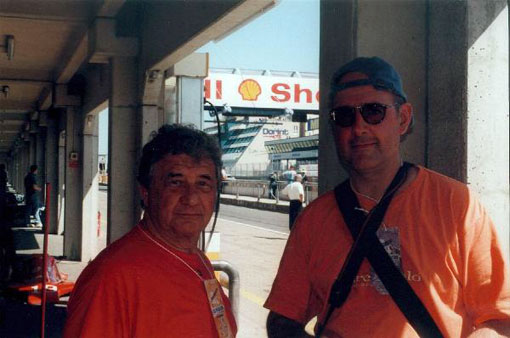
The racing career of Herrmann, who is a baker by trade, spans from cooperation with pre-war legends like Alfred Neubauer to the beginning of the dominance of Porsche at the 24 Hours of Le Mans. He started at races like Mille Miglia, Targa Florio and Carrera Panamericana and is one of the few remaining witnesses of this era. Hans im Glück (lucky John) escaped from several spectacular incidents or accidents.
Herrmann had a remarkable Mille Miglia race in 1954, when the gates of a railroad crossing were lowered in the last moment before the fast train to Rome passed. Driving a very low Porsche 550 Spyder, Herrmann decided it was too late for a brake attempt anyway, knocked on the back of the helmet of his navigator Herbert Linge to make him duck, and they barely passed below the gates and before the train, to the surprise of the spectators. He was less lucky in 1955 with the Mercedes-Benz 300 SLR as he had to abandon the race.
From 1954 to 1955, he was part of the Mercedes-Benz factory team, as a junior driver behind Juan Manuel Fangio, Karl Kling, Hermann Lang and later Stirling Moss. When the Silver Arrows came back for the 1954 French Grand Prix to score a 1-2 win, Herrmann drove the fasted lap but had to retire. A podium finish at the 1954 Swiss Grand Prix was his best result in that year as he had to use older versions of the Mercedes-Benz W196, or the least reliable car.
In the 1955 Argentine Grand Prix his team mates Kling and Moss had to abandon early due to the extremly hot conditions on the southern hemisphere in January. Herrmann was called in to share his car with them for a 4th place finish, giving one point each. Fangio won with two laps more. A crash in practise for the 1955 Monaco Grand Prix put Herrmann out for this ill-fated season.
The next years saw Herrmann racing for many marques, in F1 for Cooper, Maserati an BRM. In Berlin's AVUS during the 1959 German Grand Prix the brakes of his BRM failed, he crashed in a spectacular way, being thrown out of the car and sliding along the track with the car somersaulting in the air.
With different versions of the Porsche 718 being used as a sportscar and as Formula 2, Herrmann scored some wins for Porsche, mainly both the 1960 12 Hours of Sebring and Targa Florio. When it was turned into a Formula 1 in 1961 due to the rule changes, the results in F1 were disappointing. Herrmann left Porsche at the beginning of the 1962 season feeling that he as a local from Stuttgart was not treated equal compared to Californian Dan Gurney and 1959 GP-winner Jo Bonnier from Sweden.
With the small italian Abarth, Herrmann spend 1962 to 1965 with minor races and hillclimbing, winning only lesser sports car racing events like eg. on the AVUS.
In 1966 he returned to Porsche for a comeback in the World Sportscar Championship. Following several podium finishes with the still underpowered 2 Liter Porsche 906 and later models, he won the 1968 24 Hours of Daytona. The overall wins of the 1000km Nürburgring always went to team mates, even though Herrmann had taken part in each of these races at the Nürburgring since they were introduced in 1953.
Herrmann missed the win in the 1969 24 Hours of Le Mans with a Porsche 908 by only 100 Meters, and it was him who scored the long-awaited first overall victory at the Le Mans 24 Hours for Porsche in 1970. In heavy rain, he and his team mate Richard Attwood survived with their Porsche 917K as the best of only 7 finishers.
As promised to his wife before the race, the 42 year old immediatley retired, having witnessed fatal accidents of colleagues too many times, eg. before the 1969 German Grand Prix when his team mate and neighbor Gerhard Mitter died.

